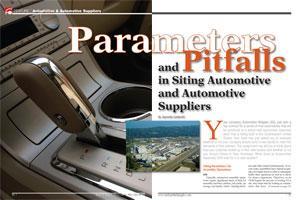

Your company, Automotive Widgets USA, just won a big contract for a series of new automobiles that will be produced at a brand new automotive assembly plant that is being built in the Southeastern United States. Your boss has just asked you to evaluate whether or not your company should build a new facility to meet the demands of that contract. This assignment has led you to think about how your customer ended up in their new location and whether or not you should follow in their footsteps. What does an Automotive Assembly OEM look for in a new location?
Siting Parameters for Assembly Operations
Site
Typically, automotive assembly operations require significant tracts of land for assembly facilities, utilities, rail yards, car storage, test tracks, visitor / training facilities and other related infrastructure. In recent years, assemblers have started acquiring even larger tracts in order to adequately buffer their operations as well as to allow for future expansions. Therefore, as an OEM begins the process of looking for a site, they must start by looking at communities that have assembled large tracts of land or where large tracts of land can be assembled. Also, OEMs who are sensitive to their scheduled demands will pay particular attention to whether or not a community has begun to do the appropriate due diligence on that site to know whether or not it is a developable site and if the necessary utility infrastructure can be extended.
Transportation Infrastructure
OEMS require rail service for delivery of outbound product. Most OEMs prefer a site that has dual-rail service. This does not mean that an automaker will actually utilize both rail companies. Rail companies serve specific territories, and utilization of any one is usually a function of service to specific markets; nevertheless, the threat of using another carrier, even if the routes are circuitous, promotes competitive pricing and service. In addition, access to an interstate highway is required by all OEMs. If a highway is not officially designated as an interstate, this does not mean it will not be considered. As long as it is built to interstate standards with controlled access, it will be considered a viable location.
Air Quality
The ability to obtain an air permit in a timely fashion is probably the most restrictive factor in the site selection process, and consequently an early screening factor.
Labor Force
Quantity and quality are tremendous concern for a company looking to hire 1,000 to 4,000 employees. Oftentimes, companies will look at the size of the potential labor shed (the area from which the plant might potentially draw its workforce) and the skill set of the workers in that labor shed. Quite often this means that they will look at the historical employment patterns – what has been the principal type of employment in the region before and what are the skill sets associated with that type of employment? One of the reasons Toyota was particularly attracted to the Tupelo region was that 32.4 percent of the available workforce within 60 miles of the site had manufacturing experience – a rate that was significantly higher than any of Toyota’s other manufacturing sites in the U.S.
New Technology
The popularity of hybrid engines has demonstrated that there is interest and demand for more fuel-efficient transportation. Consumers bought over 250,000 hybrids last year and the prospect for increased sales is expected to continue. The continued uncertainty of fuel prices will be the catalyst for innovation and radical new product development. As with any new product, until economies of scale associated with mass production manufacturing is achieved, the competitive advantage lies with those locations where research and development occurs.
Last month, the Center for Hydrogen Research in Aiken, South Carolina, rolled out its first new hydrogen vehicle. The model, a Chevrolet 1500 pickup truck, is the first hydrogen-powered on-road vehicle to be registered in South Carolina.
In addition, Smith Electric Vehicles, a division of the Tanfield Group, has confirmed that it is searching for a site to manufacture its commercial electric vans and trucks. Darren Kell, CEO of the Tanfield Group, believes that there is a U.S. market demand for 200,000 electric commercial vehicles.
Industry Outlook for Automotive Suppliers
Armed with a better understanding of what the OEMs might be looking for in a new site, the next step is to understand how this might impact Automotive Widgets USA’s decision to build a new facility. Your company has faced some tough times in recent years. Like most Tier 1 and Tier 2 automotive suppliers, Automotive Widgets USA has been under intense pressure to reduce their overall cost structure. This pressure has not let up and, in fact, continues to mount. Much of this pressure stems from a number of factors including the demands for price cuts from their OEMs – which are the result of price pressures that the OEMs are facing in the competitive automotive marketplace.
While the pressure to lower costs on all fronts continues to rise, other demands are pushing the suppliers to make new capital investments. These demands include the continued interest from the OEMs in providing just-in-time deliveries and eliminating inventories. In addition, there is an increased need for the suppliers to add research and development capabilities. Both of these items result in the need for the suppliers to continue to invest in new information technology systems.
Fortunately, Automotive Widgets USA has made some smart financial decisions and has weathered this storm in good financial shape. The company has won other contracts in addition to this current one. The company has managed to fulfill these contracts through technology and productivity gains at its existing facilities. However, it has become apparent that now it may require a new facility in order to be able to fulfill the just-in-time requirements of this latest contract.
The current plant siting model for automotive assembly operations and their suppliers usually means that the landing of an automotive final assembly plant will also result in a region receiving more than its fair share of secondary facilities that will supply the plant. Typically the supplier operations create even more jobs for the community than the automotive assembly plant itself. The Southern Automotive Corridor is a prime example of this phenomenon with hundreds of new automotive supplier companies and tens of thousands of new jobs created from Mississippi to South Carolina in the decade following the announcement of BMW in South Carolina, Mercedes, Honda, and Hyundai in Alabama, Nissan in Mississippi, and Kia in Georgia.
However, as a result of the mergers and acquisitions, the need to supply multiple OEM customers in a just-in-time fashion and the demand for cost reductions (as described above) Tier 1 and Tier 2 suppliers are siting new capital investments in more centrally-located communities. Proximity to multiple assembly plants is still one of the greatest determinants in an automotive supplier location, but the suppliers are going to be looking for ways in which they can maximize that investment to serve as many customers as possible.
As the Kia plant in Georgia and the Toyota plant in Tupelo come on line, there will continue to be investments from auto parts companies that are seeking strategic investments to serve multiple plants in the Southeast in a Just-In-Time manner.
Siting Parameters for Auto Suppliers
Sites / Facilities
One thing that is very apparent in this decision is the fact that Automotive Widgets will not have much time to make a decision about where to locate. In today’s negotiation environment between the OEMs and the suppliers, the OEMs generally push the suppliers past the point of being able to realize a Greenfield site. Therefore, Automotive Widgets USA will most likely have to look for a location that has an existing building or a spec building that meets its requirements. At the very least, a community must have a site that is ready for development in order to be successful in recruiting an automotive supplier operation in this environment.
In general, communities that have taken the time to identify sites that are suitable for development (i.e., environmental assessments are complete) and do the necessary due diligence to ensure that the site can be served by all utilities, will have an important competitive advantage. One potential example, automotive business parks provide a distinct advantage for those suppliers who produce substantial sub-assemblies and have an emphasis on time of delivery considerations.
Human Resources
Tier 1 and Tier 2 suppliers will have to continue to find ways to become more productive in order to meet the competitive demands of the current economic situation. This productivity will come in the form of new innovative processes, information technology, and highly-automated machinery. As such, these facilities will require a dramatically different skill set from a flexible and high-performance workforce.
In the case where new supplier operations are locating in a community because of proximity to an OEM, the training programs should be coordinated and in concert with the OEM training programs in terms of lean manufacturing, ISO 9000, Quality Systems, etc. For many of these suppliers, their human resources coordinator does not have time to develop a new training program (the core of which should already be done) rather they need to be focused on finding qualified people.
Supplier companies will seek partners in the local community and technical colleges to provide customized training (i.e. Six Sigma, TS 16949 certification similar to the ISO 9000 series of the past). In order to be competitive, communities will need to be in a position to provide flexible, customized start-up recruiting, screening, and pre-employment training programs to potential prospects. These programs will have to offer highly innovative screening tools and provide the well-rounded training opportunities to give the supplier companies a productive, high-performance workforce in a timely manner.
Support Structures
Similar to the Human Resource constraints discussed above, suppliers do not have the management or support structure of an OEM to put in place in a new location. Having support structures in your communities that will help new companies find things like service providers for equipment, relocation assistance, banking connections, contractors, etc. can be a Herculean task in a new location. Having a “one-stop” task force to get them connected and grounded in the community is important – more than important.
Costs
Obviously, one of the important drivers for Automotive Widgets USA will be the need to find locations that will help the company continue to lower their overall cost structure. The ability for a community to mitigate the up-front development costs as well as the ongoing operating costs such as utility and labor costs will be critical. As many of these companies come out of mergers, acquisitions and other corporate re-structuring the availability of income tax incentives will be less critical than the availability of other long-term, operating cost reductions. Good examples of the types of operating cost incentives that will be attractive to companies in this industry include property tax incentives, long-term, flexible utility rate riders, lower workers compensation rates, etc. In addition, the need to assist with up-front, start-up costs such as site preparation and facility construction will be important considerations
Companies such as Automotive Widgets USA will continue to make important investments and the automotive supplier industry as a whole will continue to be an important contributor to this nation’s economy. However, it will have to adapt to dramatically changing economic conditions and these changes will impact their facility siting process and ultimate location choices.

